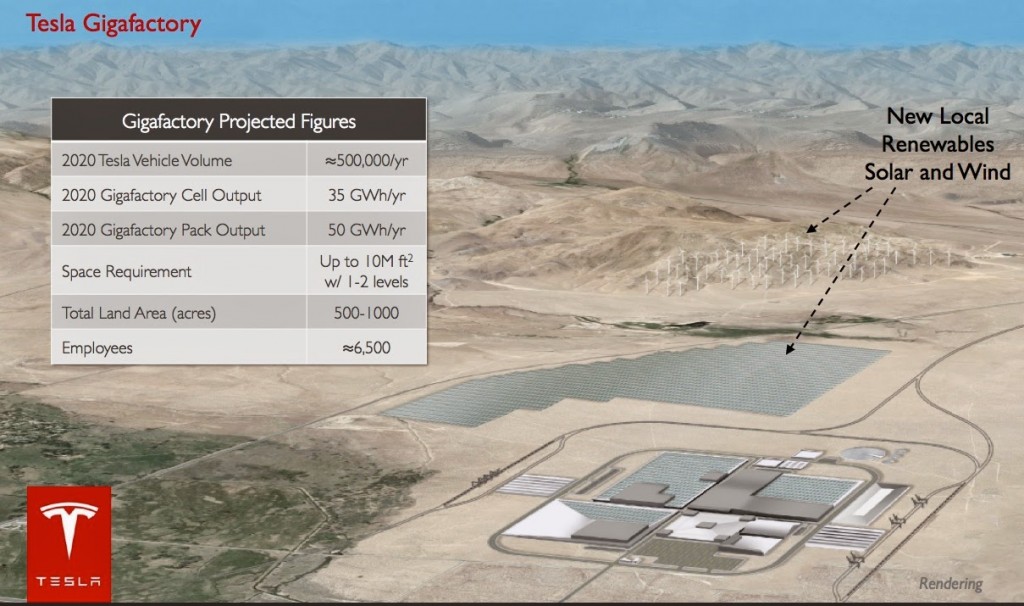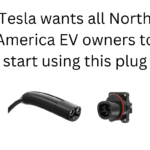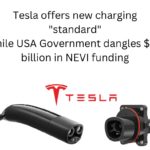Tesla Motors is still saying the Tesla Model 3 will go on sale in 2017, despite my prediction the date will slip. To make that date the company has to ramp up the gigafactory, and time is ticking. Since that’s the key, what’s the latest news? It’s been almost a month since Tesla Motors confirmed that the Tahoe-Reno Industrial Center is a potential Gigafactory site. That free’d up the contractor to speak about the job they’d done. And, there’s some news to discuss about the incentives packages being offered by the states.
The Reno-Gazette Journal was able to talk with the owner of F and P Construction![]() , the company hired to prepare the site. F&P Construction hired 250 men and women, and used $65 million worth of equipment — 200 pieces of equipment, bulldozers, excavators, haul trucks. They moved 3 million cubic yards of “dirt and brush” to level the site, big enough to hold a 5 million square feet building. The goal was to finish work by July 21 to prepare for a site visit by Panasonic.
, the company hired to prepare the site. F&P Construction hired 250 men and women, and used $65 million worth of equipment — 200 pieces of equipment, bulldozers, excavators, haul trucks. They moved 3 million cubic yards of “dirt and brush” to level the site, big enough to hold a 5 million square feet building. The goal was to finish work by July 21 to prepare for a site visit by Panasonic.
Our coverage of that project occurred at about that time, and operations shut down by the 25th when it appeared plausible that Tesla had pulled out of the Reno site. Since then Tesla and Panasonic announced an agreement to codevelop the Gigafactory.
According to the developer of the TRIC, Lance Gilman, work has not stopped at the Tesla site. he said: “There’s still ongoing things, building catch basins, rerouting flood control, bank stabilization. But the pad is finished. It’s ready.” Gilman also said the “steel” had already been ordered, which may or may not be a sign that Tesla will choose the Reno location. Gilman said the steel could be reused in some other project if Tesla decides to not use the site.
What Tesla is doing is a high stakes game of playing one state off another. The company is doing, as do so many other companies, its best to wangle the best deal from the host state.
The Detroit News has a list of the states![]() , and the incentives being offered in each. It also says Elon Musk has said the winning state is expected to shoulder 10% of the Gigafactory’s cost or about $500 million.
, and the incentives being offered in each. It also says Elon Musk has said the winning state is expected to shoulder 10% of the Gigafactory’s cost or about $500 million.
Reno Nevada: The state has no taxes on a long list of activities, and close proximity to important raw materials including lithium mining. There is a direct rail connection from Reno to Fremont, where Tesla’s car factory is located.
California: The state legislature has enacted tax credits etc that benefit certain kinds of corporations, including aerospace and battery manufacturing. Sales tax is also waived on the first $200 million of capital equipment purchases for those companies. The legislature is considering waiving environmental rules.
Texas: The Texas Enterprise Fund regularly gives tens of millions of dollars for companies opening new operations. SpaceX has received over $10 million from the TEF. The Texas Emerging Technology Fund is another source of money. There are additional tax credits, and some cities like Austin has offered additional incentives.
New Mexico: A long list of tax credits are available for manufacturers. Cities can tap public funds to build roads and other infrastructure around factories. The state has low tax rates, rail connections to California, and low electricity rates.
Arizona: Tax credits for manufacturing, and another tax credit for each employee. There’s a tax credit if Tesla were to install enough solar power capacity. Facilities located in foreign trade zones get another large tax credit.
- Highway design could decrease death and injury risk, if “we” chose smarter designs - March 28, 2015
- GM really did trademark “range anxiety”, only later to abandon that mark - March 25, 2015
- US Government releases new regulations on hydraulic fracturing, that some call “toothless” - March 20, 2015
- Tesla Motors magic pill to solve range anxiety doesn’t quite instill range confidence - March 19, 2015
- Update on Galena IL oil train – 21 cars involved, which were the supposedly safer CP1232 design - March 7, 2015
- Another oil bomb train – why are they shipping crude oil by train? – Symptoms of fossil fuel addiction - March 6, 2015
- Chevron relinquishes fracking in Romania, as part of broader pull-out from Eastern European fracking operations - February 22, 2015
- Answer anti- electric car articles with truth and pride – truth outshines all distortions - February 19, 2015
- Apple taking big risk on developing a car? Please, Apple, don’t go there! - February 16, 2015
- Toyota, Nissan, Honda working on Japanese fuel cell infrastructure for Japanese government - February 12, 2015













